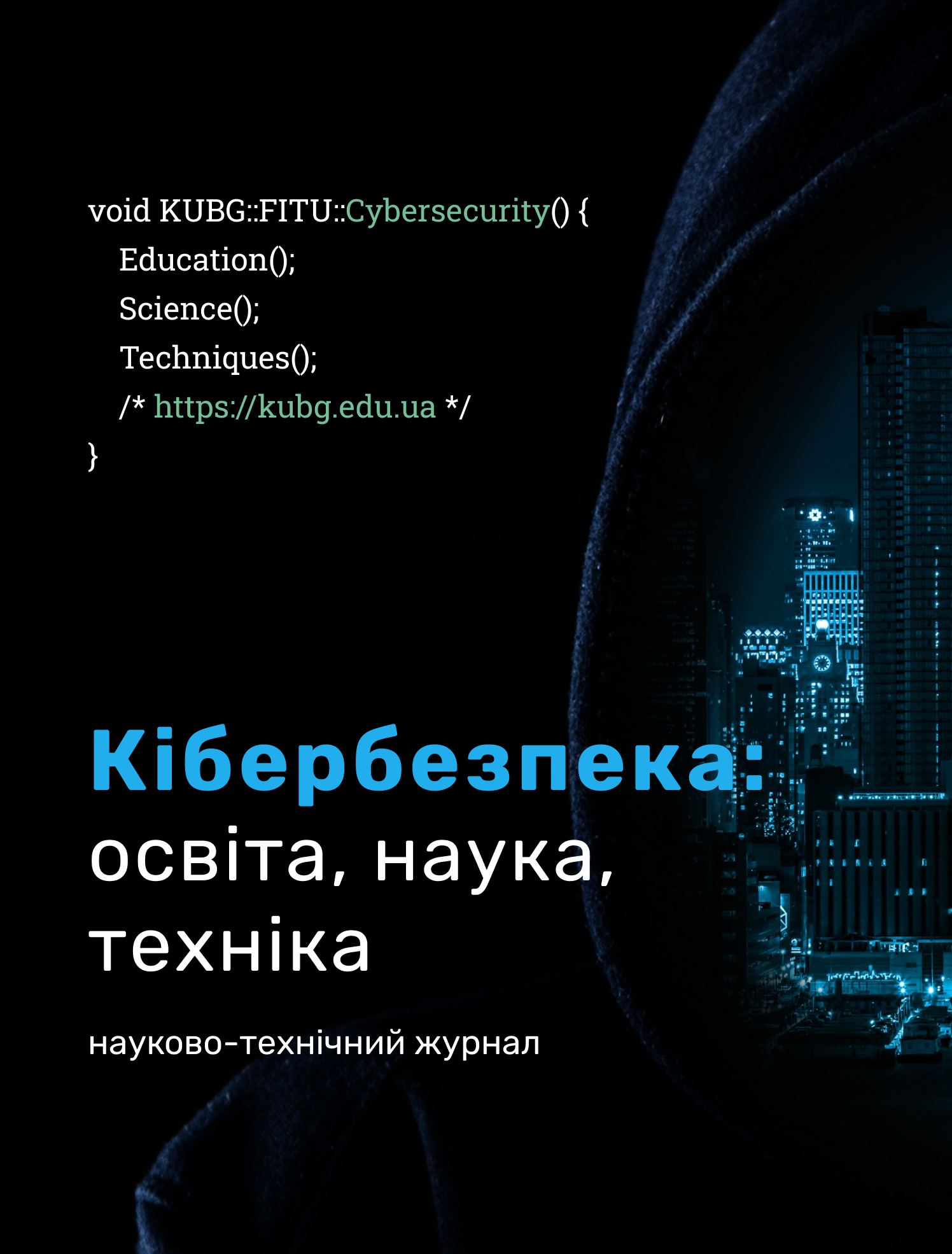THE PROBLEM OF CYBER SECURITY PROFESSIONALS TRAINING: APPLIED ORIENTATION OF MATHEMATICAL DISCIPLINES
DOI:
https://doi.org/10.28925/2663-4023.2021.13.123132Keywords:
cybersecurity, information security, mathematical disciplines, applied orientation.Abstract
The study substantiates the urgent need to train qualified specialists capable of responding to cyber incidents and countering cyber threats in a short time, conducting state audits and creating effective management systems for information security and cybersecurity.
The aim of the work is to reveal the ways and features of the organization of the study of mathematical disciplines in order to effectively train higher education students majoring in 125 «Cybersecurity».
The role of the mathematical component of cybersecurity and the organization of the educational process of mathematical disciplines for the purpose of effective professional training of future cybersecurity specialists is considered. It is concluded that most professionally-oriented disciplines that provide basic knowledge in all aspects of information security are based on fundamental mathematical training. The study argues that the applied problems solved by the students of the specialty 125 «Cybersecurity» must meet the methodological requirements for real practical content, which provides an illustration of the practical value and significance of the acquired mathematical knowledge in the cyber- and/or information security field.
The solution to the problem of improving the quality of mathematical training of the students is considered through the use of intra-subject and interdisciplinary links, the introduction of applied orientation of mathematical disciplines and the principle of continuity. The paper presents examples of professionally oriented tasks that are offered to higher education students majoring in 125 «Cybersecurity» studying mathematical disciplines. It is proved that the introduction of applied orientation of mathematical disciplines creates the necessary conditions and attracts students to the professional sphere, which is an important step towards improving the quality of training of cybersecurity professionals.
Downloads
References
Buriachok, V. L. ta in. (2015). Informatsiina ta kiberbezpeka: sotsiotekhnichnyi aspekt (V. Tolubko, Red.). DUT.
134 cybersecurity statistics and trends for 2021 | varonis. Inside Out Security. https://www.varonis.com/blog/cybersecurity-statistics/
Center for internet security. making the connected world a safer place. https://www.cisecurity.org/
Buriachok, V. L. ta in. (2018). Model pidhotovky fakhivtsiv u sferi informatsiinoi ta kibernetychnoi bezpeky v zakladakh vyshchoi osvity Ukrainy. Informatsiini tekhnolohii i zasoby navchannia, 67(5), 277–289.
Korzhova, O. V. (2017). Teoretychni aspekty mizhpredmetnykh zviazkiv matematychnykh dystsyplin z dystsyplinamy tsyklu profesiinoi pidhotovky maibutnikh fakhivtsiv iz orhanizatsii informatsiinoi bezpeky. Fizyko-matematychna osvita, (2), 89–93.
Buriachok, V. L., Bohush, V. M. (2018). Rekomendatsii shchodo rozrobky ta realizatsii modeli profesiinykh kompetentnostei u sferi pidhotovky fakhivtsiv dlia natsionalnoi systemy kiberbezpeky. Zakhyst informatsii, 20(2), 72–78.
Buriachok, V., & Sokolov, V. (2019). Implementation of Active Learning in the Masters Program on Cybersecurity. U Advances in Computer Science for Engineering and Education II (s. 610–624). Springer International Publishing. https://doi.org/10.1007/978-3-030-16621-2_57
Danyk, Yu. H., Suprunov, Yu. M. (2011). Deiaki pidkhody do formuvannia systemy pidhotovky kadriv dlia systemy kibernetychnoi bezpeky Ukrainy. Zbirnyk naukovykh prats ZhVI NAU «Informatsiini systemy», (5), 5–22.
Minochkin, A. I. (2011). Informatsiina borotba: suchasnyi stan ta dosvid pidhotovky fakhivtsiv. Oboronnyi visnyk, (2), 12–14.
Melnyk, S. ta in. (2018). Orhanizatsiia fakhovoi pidhotovky maibutnikh fakhivtsiv z kiberbezpeky na osnovi innovatsiinoi pedahohiky ta intehrovanoho pidkhodu v systemi realizatsii kliuchovykh kompetentsii bezpeky v informatsiinomu suspilstvi. Vytoky pedahohichnoi maisternosti, (21), 125–129.
Shevchenko, S. M. ta in. (2017). Statystychna obrobka eksperymentalnykh danykh yak odna z form naukovo-doslidnoi roboty studentiv spetsialnosti «Kiberbezpeka». Suchasnyi zakhyst informatsii, (2), 95–103. http://nbuv.gov.ua/UJRN/szi_2017_2_17.
Shevchenko, S. M. ta in. (2020). Provedennia swot-analizu otsiniuvannia informatsiinykh ryzykiv yak zasib formuvannia praktychnykh navychok studentiv spetsialnosti 125 Kiberbezpeka. Kiberbezpeka: osvita, nauka, tekhnika, 2(10), 158–168. https://www.csecurity.kubg.edu.ua/index.php/journal/article/view/216
Metcalf, L., & Casey, W. (2016). Cybersecurity and Applied Mathematics: 1st Edition. Syngress.
Do You Need Math for Cybersecurity? – StartaCyberCareer.com. StartaCyberCareer.com – Start a Cybersecurity Career. https://startacybercareer.com/do-i-need-math-for-cyber-security/
Cybersecurity - Math - Guide - Education - Degree - School. Online Masters Degree in Cybersecurity | Guide to Cybersecurity Graduate Programs. https://www.cybersecurityeducationguides.org/cybersecurity-and-math-guide/
How much Math is there in a Cyber Security Degree?. DegreeQuery.com. https://www.degreequery.com/how-much-math-is-there-in-a-cyber-security-degree/
Program: Applied Mathematics and Computer Science, B.S. (Cyber Security Concentration) - University of Wisconsin Stout - Acalog ACMS™. https://bulletin.uwstout.edu/preview_program.php?catoid=10&poid=2054&hl=cyber%20security&returnto=search
Krylova, T. V., Steblianko, P. O. (2008). Profesiino oriientovane navchannia matematyky v tekhnichnomu vuzi – pershocherhova zadacha sohodennia. Visnyk Cherkaskoho universytetu. Seriia: Pedahohichni nauky, (127), 98–102.
Mathematics education in Europe : common challenges and national policies. https://op.europa.eu/en/publication-detail/-/publication/3532f22d-eea2-4bb2-941b-959ddec61810
Dowker, A. (2009). What works for children with mathematical difficulties. DCSF. https://www.researchgate.net/publication/253032270_What_Works_for_Children_with_Mathematical_Difficulties
Cyber Information Sharing: Building Collective Security. World Economic Forum - Home. http://www3.weforum.org/docs/WEF_Cyber_Information_Sharing_2020.pdf
Vidomosti pro samootsiniuvannia osvitnoi prohramy125 Kiberbezpeka. Mariupolskyi derzhavnyi universytet - Holovna storinka. http://mdu.in.ua/Ucheb/lits/samootsinka/bak/samoocinjuvannja_op_kiberbezpeka_2020-2021.pdf
Standart vyshchoi osvity Ukrainy: pershyi (bakalavrskyi) riven, haluz znan 12 – Informatsiini tekhnolohii, spetsialnist 125 – Kiberbezpeka. Holovna | Ministerstvo osvity i nauky Ukrainy. https://mon.gov.ua/storage/app/media/vishcha-osvita/zatverdzeni%20standarty/12/21/125-kierbezpeka-bakalavr.pdf
Osvitno-profesiina prohrama 125 Kiberbezpeka. Mariupolskyi derzhavnyi universytet - Holovna storinka. http://mdu.in.ua/Ucheb/OPP/bak-2019/kiberbezpeka.pdf
Buldyhin, V. V. ta in. (2011). Liniina alhebra ta analitychna heometriia: navch. posibnyk (V. Buldyhin, Red.). TViMS.
Published
How to Cite
Issue
Section
License

This work is licensed under a Creative Commons Attribution-NonCommercial-ShareAlike 4.0 International License.




